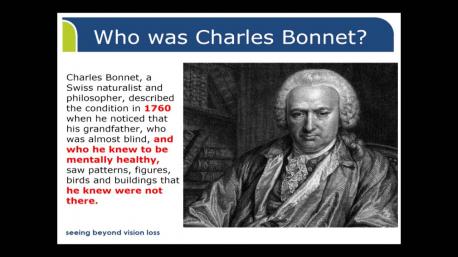Results: Charles Bonnet Syndrome
Published on 08/16/2017
Charles Bonnet Syndrome (CBS) is a condition that causes vivid, complex, recurring visual hallucinations, usually (but not only) in older adults with later-life vision loss. The "visual hallucinations" associated with CBS can range from animated, colorful, dreamlike images to less complex visions of people, animals, vehicles, houses, and similar everyday images.
Individuals who perceive these visions know they're-mirages, of sorts. That is, the images are illusions, not delusions. The difference is that a person with delusions is convinced that what s/he sees is real. People with Charles Bonnet Syndrome may initially second-guess themselves but ultimately accept that their perceptions have no substance. CBS is sometimes referred to as "phantom vision" syndrome, and can be compared to "phantom limb" syndrome, in which an individual can continue to receive sensation—and even pain signals—from a limb that has been amputated.
You can read the complete article in http://www.visionaware.org/info/your-eye-condition/guide-to-eye-conditions/charles-bonnet-syndrome/124

QUESTIONS
GO to COMMENTS
Comments
1.
1.
(Video source: TED) Before this survey, did you ever hear about Charles Bonnet Syndrome?
Yes
8%
149 votes
No
92%
1807 votes
2.
2.
Adults with CBS are usually in good mental health and come to understand that these illusions or "hallucinations" are not sensate or "real." In addition, the illusions associated with CBS are solely visual and do not occur in conjunction with the other senses (hearing, smell, taste, or touch). Did you know that something similar happens to many people who became deaf? They hear ghost sounds, even when they can't hear anymore. It's not accompanied by visual signals.

Yes
10%
187 votes
No
90%
1769 votes
3.
3.
I always thought that visual or audible hallucinations were exclusively affecting people with mental health issues. After finding out about this illness, I realized it's not exclusively related to mental health. Can you mention any other illness that leads to images, sounds or sensations which patients know they are not real?
Yes
12%
233 votes
No
88%
1723 votes
4.
4.
These techniques are helpful to lessen or manage images and hallucinations: Please indicate which ones you've heard about before this survey.
Closing the eyes and then opening them
10%
192 votes
Looking away, or walking away, from the images or hallucinations
8%
147 votes
Staring at, or fixating on, the images
5%
103 votes
Turning on a light
9%
178 votes
Concentrating on something else/looking for distraction
8%
160 votes
Approaching and/or hitting at the image or hallucination
4%
69 votes
Shouting at the image or hallucination
3%
62 votes
Other (please specify)
0%
9 votes
Not Applicable
76%
1495 votes
| Other Answers | Percentage | Votes |
|---|---|---|
| 0.54% | 5 | |
| V | 0.11% | 1 |
| i am lucky to see with reading glasses | 0.11% | 1 |
| within the dream, change direction, take charge and say no. this is an alternate reality over which you have control and can make choices | 0.11% | 1 |
| praying to our Lord Jesus! | 0.11% | 1 |
COMMENTS


